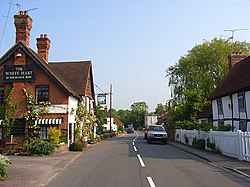Shurlock Row
| Shurlock Row | |
| Berkshire | |
|---|---|

| |
| Location | |
| Grid reference: | SU833744 |
| Location: | 51°27’51"N, 0°48’12"W |
| Data | |
| Post town: | Reading |
| Postcode: | RG10 |
| Dialling code: | 0118 |
| Local Government | |
| Council: | Windsor and Maidenhead |
| Parliamentary constituency: |
Windsor |
Shurlock Row is a village eastern Berkshire.
The village lies in the heart of the Thames Valley, around five and a half miles southwest of Maidenhead and around three miles east of Twyford. The M4 motorway passes just to the south of the village.
History
Billingbear Park, just south of the village, was the centre of Binfield Walke or Fines Bayliwick, the greatest of the sixteen red-deer stocked sub-divisions into which Windsor Forest was split. It was granted to Sir Henry Neville by Edward VI in 1549. He was the younger brother of the 5th Lord Bervagenny and a descendant of the Nevilles of Bisham & elsewhere. His fine monument (1593) can be seen in the parish church. Sir Henry’s son and namesake was Ambassador to France, but was implicated in the Earl of Essex’ plot against Elizabeth I and imprisoned in the Tower of London.
During the Civil War, the area was deeply divided: Colonel Richard Neville of Billingbear House fighting on the opposite side to his Parliamentarian brother, Henry. After Charles II was restored to the throne, the house was the scene of a great dinner party. The King, the Duke of York, Prince Rupert and many other nobles rode over from Windsor in 1667. The fine Elizabethan House burnt down earlier this century.
It appears to have been in this area that Mabel or Arabella Elsmore, a local 17th century witch lived. She married one Ralph Medwin in 1622 and together they had at least two children. We know nothing of the crimes of which she was accused but, at the age of sixty-eight, she appears to have fallen victim to the witch-hunters of the age. She was executed (burnt?) at Reading in 1656 and buried at Waltham St Lawrence.[1]
The Village Today
Shurlock Row is a linear village. Until recently, there were two public houses in the village: The Royal Oak and The White Hart. The Royal Oak closed down in 2009 and is now a private dwelling named Morland House. When The White Hart came under threat, a group of 17 villagers bought the pub and turned it into a popular gastropub, called The Shurlock Inn.[2] This is an uncommon success story which goes against the trend of disappearing village amenities across the country. Shurlock Row itself has lost its general store, butcher shop and post office in the last 20 years. The village church has also been converted into a residential property.
To the south of the village, farmland separates the houses from the M4 motorway. The pub and a garage are found in the centre of the village, amongst the main body of houses. The northern edge of the village is marked by the village pond, which lies next to a crossroads. To the north-west of the pond is the parish cricket ground and to the immediate north-east is Great Martins, a large house and former village brewery.[3]
Due to the beauty of the settlement's buildings, surrounding woodland and farmland and its close proximity to London, Shurlock Row is an attractive and desirable village. Many villagers work in the local towns of Maidenhead, Reading and Bracknell, although there are a number who commute to London regularly. Popular sports in the area include cricket, cycling and horse riding. The village and surrounding area is also well known for its polo clubs and grounds. Shurlock Row is the home of the Zacara Polo Team, winners of the 2011 Veuve Clicquot Gold Cup for the British Open Polo Championship and the 2012 the U.S. Open Polo Championship.
The other village in the parish, Waltham St Lawrence, is larger and provides a number of amenities that Shurlock Row lacks, including a church and village hall, so many village events and meetings are held there.
Outside links
| ("Wikimedia Commons" has material about Shurlock Row) |
References
- ↑ History of Shurlock Row – Royal Berkshire History
- ↑ "Berkshire - Places - No last orders at the Shurlock Inn". BBC. 2009-06-17. http://www.bbc.co.uk/berkshire/content/articles/2009/03/18/maggie_pub_feature.shtml. Retrieved 2012-09-18.
- ↑ "Domesday Reloaded: Places in Shurlock Row". BBC. 1970-01-01. http://www.bbc.co.uk/history/domesday/dblock/GB-480000-174000/page/8. Retrieved 2012-09-18.